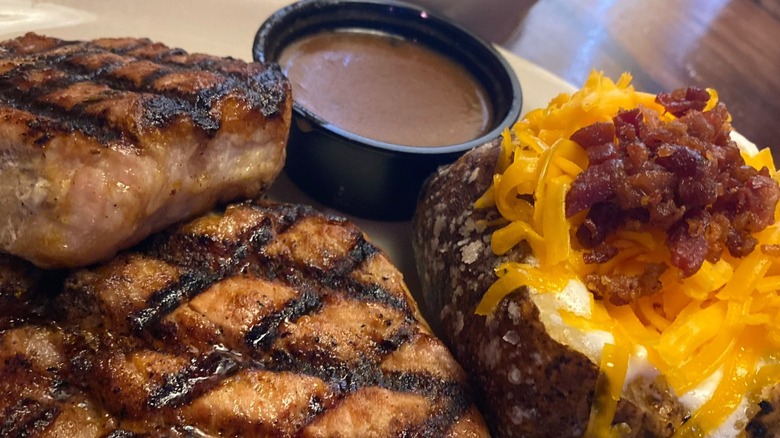The Ingredient That Gives Texas Roadhouse's Steak Sauce Its Unique Flavor
Texas Roadhouse is a mid-priced steakhouse chain (there's really no such thing as a cheap one these days) known for many things, among them are its ever-popular rolls with honey-cinnamon butter and those underrated free peanuts you get to throw on the floor. Still, if you're going there by choice, it's most likely because you want to order a steak, which is generally a good idea at a steakhouse.
Once you've decided on which cut to get (here's our worst-to-best ranking, if you need any help making up your mind), your next decision is to sauce or not to sauce. If you've popped for any of the optional add-ons such as blue cheese crumbles or sauteed mushrooms, steak sauce may be de trop, but if you're going with just a bare-naked steak, then you may well want to use the chain's signature sauce. Should you do so, though, you might find yourself trying to pin down its elusive flavor. Just what's in the stuff?
In addition to such expected ingredients as vinegar, tomato paste, corn syrup, and salt, along with the usual colorings and preservatives, Texas Roadhouse steak sauce contains two fruity surprises: tamarind (which is also found in Worcestershire sauce) and raisin paste. That's right, raisin haters, you've been eating your arch-nemesis all along and you never even guessed!
Another famous steak sauce also uses this ingredient
Why raisins, you may ask? Well, the answer is that these provide some natural sweetness in addition to the somewhat less natural kind from the corn syrup. While raisins are something we often associate with sugary baked goods such as cinnamon rolls, from time to time they pop up in savory dishes such as picadillo. As for raisins in steak sauce, Texas Roadhouse isn't the first place to get the idea of using them. In fact, the chain's sauce is a pretty close dupe of another famous name: A.1.
A.1. Sauce, which has been around since the 19th century, contains a fairly similar list of ingredients to Texas Roadhouse's condiment, with one main exception being that it uses orange puree instead of tamarind extract. It, too, however, lists raisin paste in the fifth spot on the ingredients list. This doesn't mean that the sauces taste exactly alike, though. They're different enough that people can tell them apart, and unsurprisingly, some prefer one sauce while some favor the other. An Amazon reviewer, who claims to have been a lifelong A.1. fan, says the Texas Roadhouse sauce made a convert out of them, but a Trip Advisor user thinks TR's condiment is way too sweet and seriously regrets not using A.1. instead.

